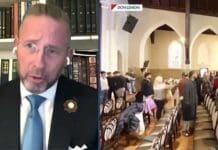In a 17-minute video, Phil Vischer, one of the creators of VeggieTales and the voice of Bob the Tomato, takes viewers through a U.S. history lesson that is uncomfortable at times. Seeking to explain why people feel the need to protest, are angry, and why the conversation around racial reconciliation has come up again following the death of George Floyd, Vischer says that even in 2020, there exists a massive and unjust disparity between African Americans and white Americans. What’s more, this disparity “didn’t happen by accident; it happened by policy.”
Vischer summarizes his well-researched argument in seven sentences:
We, the majority culture, told [black Americans] where they could live, and where they couldn’t. Then we moved most of the jobs to the places we told them they couldn’t live. When the predictable explosion of unemployment and poverty resulted in a predictable increase in drug use and crime, we criminalized the problem. We built $19 billion of new jails and sold grenade launchers to the police. As a result, a white boy born in America today has a one in 23 chance of going to prison in his lifetime. For a black boy, it’s one in four. And that is why people are angry.
Written by Phil and his brother, Rob, the video starts with a statistic comparing an average white household to an average black household. Black households have 60 percent of the income of white households, but only one-tenth of the household wealth. This is a big deal because household wealth “helps send kids to school, helps launch small businesses, stabilizes loss of income, and helps families survive catastrophic events like divorce or unemployment.”
It’s true that there are lots of wealthy African Americans: 75 percent of the NBA, 70 percent of the NFL, movie stars, pop stars, Oprah Winfrey, etc. Yet with all these extremely wealthy African Americans thrown into the statistics for the average black household, and with the extremely poor white people thrown into the white household stats, we still see this alarming disparity.
Why the Disparity?
Vagrancy Laws
Vischer goes back to just after the Civil War ended to explain how this disparity started. After slavery ended in the U.S., nine states enacted “Vagrancy Laws,” essentially making it illegal for African Americans to not have a job–the law was only applied to black men. Eight of those states allowed black prisoners–those who had been arrested for not having a job–to be hired out to plantation owners for little to no pay. In other words, “Men who had been freed from the plantations found themselves right back on the plantations.”
Additionally, Vischer implies, frivolous laws prohibited “mischief” and “insulting gestures” which only led to more black men being arrested and created “a huge market for convict leasing.” Working conditions while incarcerated, Vischer explains, could be worse than the conditions they experienced during slavery as the plantation owner leasing the black prisoner had no concern for the man’s longterm wellbeing.
Jim Crow Laws
By 1900, every state in the south had Jim Crow laws in place. Vischer described these as “social ostracism laws” that extended to schools, churches, housing, jobs, restaurants, hospitals, prisons, funeral homes, morgues, and cemeteries. Vischer highlighted the way politicians strove to outdo one another by getting more and more specific with the laws, like one prohibiting interracial chess playing.
Not only did the state governments of the south perpetuate these laws, but in 1896, the U.S. Supreme Court ruled that Jim Crow laws “reflected customs and traditions” and “preserved public peace and good order.” The laws stayed in place until 1954, when the Brown v Board of Education case came to the Supreme Court.
However, the Brown ruling didn’t convince the southern states to change their Jim Crow laws. In 1956, the “Southern Manifesto” was signed by 101 out of 128 congress members from the south and inspired 50 new Jim Crow laws. White private schools, called “Segregation Academies”, popped up across the south. Vischer points out that many of these schools were Christian.
Widespread civil rights protests, combined with anti-war protests were becoming violent by this point. Things had gotten so bad that in 1968, 81 percent of Americans believed “Law and order has broken down in this country,” and the majority saw communists and “negroes who start riots” as good demographics to blame. Politicians responded with rhetoric designed to convince voters they would restore law and order. For instance, Richard Nixon campaigned on a platform of law and order.















